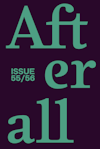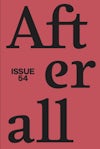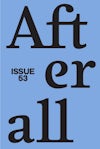
Issue 14
Autumn/Winter 2006
Editors: Charles Esche, Thomas Lawson, Mark Lewis, Pablo Lafuente.
Founding editors: Charles Esche, Mark Lewis.
Table of contents
Foreword
Contextual Essays
- ‘Is Modernity our Antiquity?’ Your Art World: Or, The Limits of Connectivity – Lane Relyea
Artists
Ibon Aranberri
- Ibon Aranberri: Footprints – Peio Aguirre
- The Logic of Stories – Pip Day
Bernadette Corporation
- An Independent Group? Bernadette Corporation, Post-Pop Collective – Janet Sarbanes
- Burn a Debt to the Present – Jian-Xing Too
Bernadette Corporation
- Be Corpse
Andrea Bowers
- Andrea Bowers’s History Lessons – Jill Dawsey
- Bad Example: Andrea Bowers – Mike Sperlinger
Ivan Grubanov
- Tyranny and Tribalism: The Art of Ivan Grubanov – Rebecca Gordon Nesbitt
- Ivan Grubanov: Close Encounters – Philippe Pirotte
Julie Mehretu
- Julie Mehretu’s ‘Perfect’ Pictures – Peter Eleey
- Towards Abstraction: Indeterminacy and the Internationalisation of Julie Mehretu’s Paintings – Lauri Firstenberg
Foreword
Written by Pablo Lafuente
Friedrich and August Wilhelm Schlegel published the first issue of the Athenäum journal in May 1798. Their intention was to create a platform from which the brothers and their circle…
There are so many critical journals of varying sorts and different intentions!
If only a society might be formed sometime with the sole purpose of gradually
making criticism – since criticism is, after all, necessary – a real thing.
Friedrich and August Wilhelm Schlegel published the first issue of the Athenäum journal in May 1798. Their intention was to create a platform from which the brothers and their circle (including Schleiermacher, Novalis and Dorothea and Caroline Schlegel) could express their views on art, philosophy and science. The material form of the journal seemed appropriate, because ‘publishing is to thinking as the maternity ward is to the first kiss’.
The journal was published twice a year (instead of six times as originally planned) and only six issues were produced (the last in 1800), but the model of criticism that was exercised and reflected upon in its pages shifted the understanding of what thinking (and writing) about art means. At the time, the cannon for the practice of criticism was Alexander Pope’s Shakespeare edition of 1725, in which the author ‘drew attention to passages he liked by asterisks in the margin, explaining that this system “seems … a shorter and less ostentatious method of performing the better half of criticism (namely the pointing out of an author’s excellencies) than to fill a whole paper with citations of fine passages, with general Applauses, or empty Exclamations at the tail of them”.’
For Pope, the stress was on the ‘fine passages’, and the strategy was one of mere indexing. Against this celebration of the detail, the Schlegels proposed a consideration of the work of art as an organic whole, an individual work in the context of the author’s production and in relation to the recurrent revisiting of contemporary and classical works. Counter to Pope’s strategy, they stressed the need for analysis, which, perfectly compatible with an experience of pleasure, led to aesthetic judgement. This judgement was not to be made according to general laws, but according to the work’s individual ideal – as an investigation into whether the work was consistent with the rules it imposed upon itself.
Purchase
The publication is available for purchase. If you would like specific articles only, it is also available individually and to be downloaded as PDFs.
Purchase full publication
Buy via University of Chicago Press
Buy via Central Books
Purchase individual articles
Buy via University of Chicago Press



